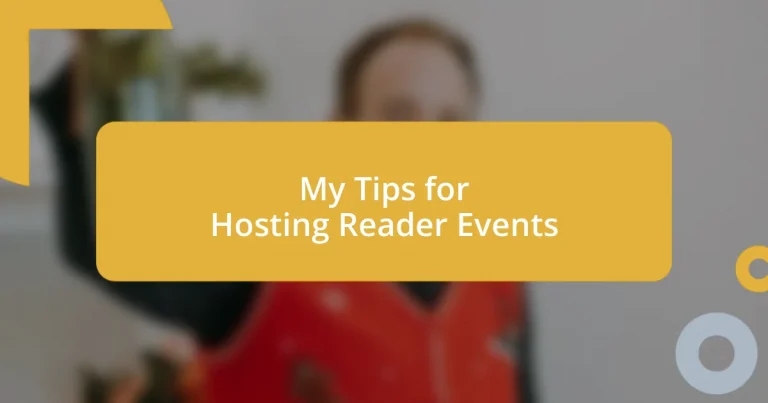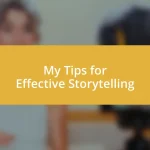Key takeaways:
- Reader events provide a unique space for connection, creativity, and the exchange of personal stories, fostering community among participants.
- Effective planning includes balancing structured activities with informal networking, accommodating attendees’ preferences, and selecting an accessible, inviting venue.
- Post-event follow-up is crucial for maintaining connections, gathering feedback, and promoting future engagement, enhancing the sense of community among attendees.
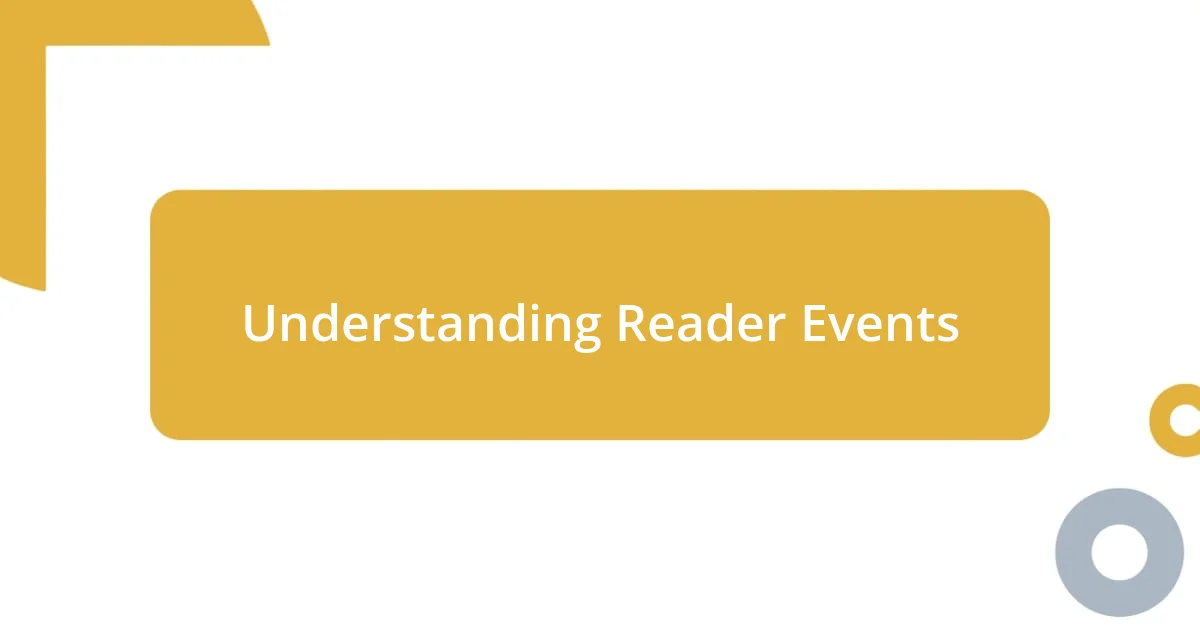
Understanding Reader Events
When I think about reader events, I envision a vibrant space for connection that goes beyond just discussing books. It’s a unique opportunity for authors and readers to bond over shared passions, ideas, and perspectives. Have you ever felt that electric excitement in the air when a group of like-minded individuals gathers to chat about a favorite novel? It’s truly an experience that can foster deep relationships.
The magic of reader events lies in the exchange of stories—not just the ones within the pages of books, but personal narratives that emerge during discussions. I remember my first reader event; it was a simple gathering at a local bookstore, but I walked away feeling like I’d found my tribe. The gentle hum of laughter and the heartfelt debates about character motivations transformed those strangers into friends.
Reader events are also powerful for sparking creativity. Have you noticed how a casual conversation can inspire new ideas? I’ve often left these gatherings with a refreshed perspective, eager to dive into my next reading adventure or even start drafting my own story. They are not just gatherings; they are catalysts for community, creativity, and inspiration.
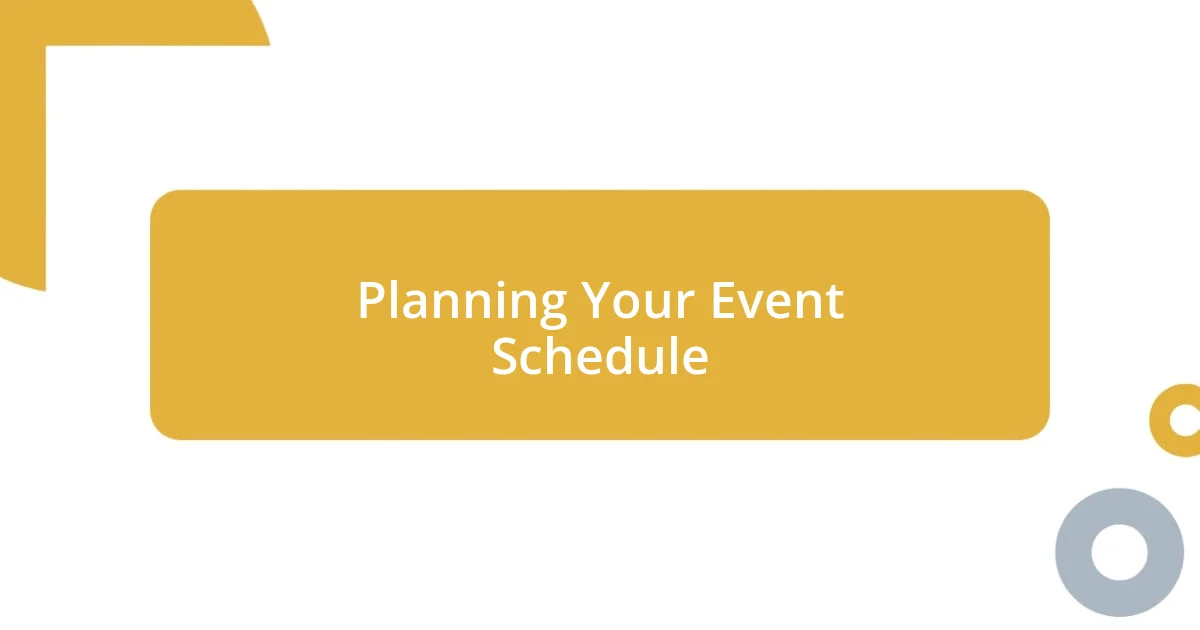
Planning Your Event Schedule
Planning your event schedule is crucial for ensuring that everything runs smoothly. I’ve learned from experience that creating a balanced agenda helps maintain energy throughout the day. When I organized my first reader event, I packed the schedule too tightly. As a result, conversations felt rushed, and attendees didn’t have a chance to connect fully. Now, I always leave time for casual interactions; it’s during these moments that the real magic happens.
In my opinion, mixing different types of activities makes the event more engaging. For instance, I often combine panel discussions with interactive workshops. This approach keeps attendees on their toes and encourages participation. You might consider scheduling a Q&A session after a reading, so people can share their thoughts and get involved. Finding the right balance between structure and spontaneity can lead to enriching experiences that everyone remembers long after the event.
Let’s also think about logistics when crafting your schedule. Timing can drastically affect attendance, so I try to accommodate varying preferences by testing different time slots. Feedback from previous hosts showed that weekend afternoons worked best for the majority. If you’re unsure, don’t hesitate to survey your audience. Adapting to their needs not only shows you care but also enhances participation and enjoyment.
| Schedule Element | Comments |
|---|---|
| Keynote Speech | Start strong with an inspiring message. |
| Panel Discussion | Encourage diverse perspectives on chosen topics. |
| Breakout Sessions | Foster deeper connections and hands-on engagement. |
| Networking Time | Allow for informal interactions among attendees. |
| Feedback Collection | Gather insights for future improvements. |
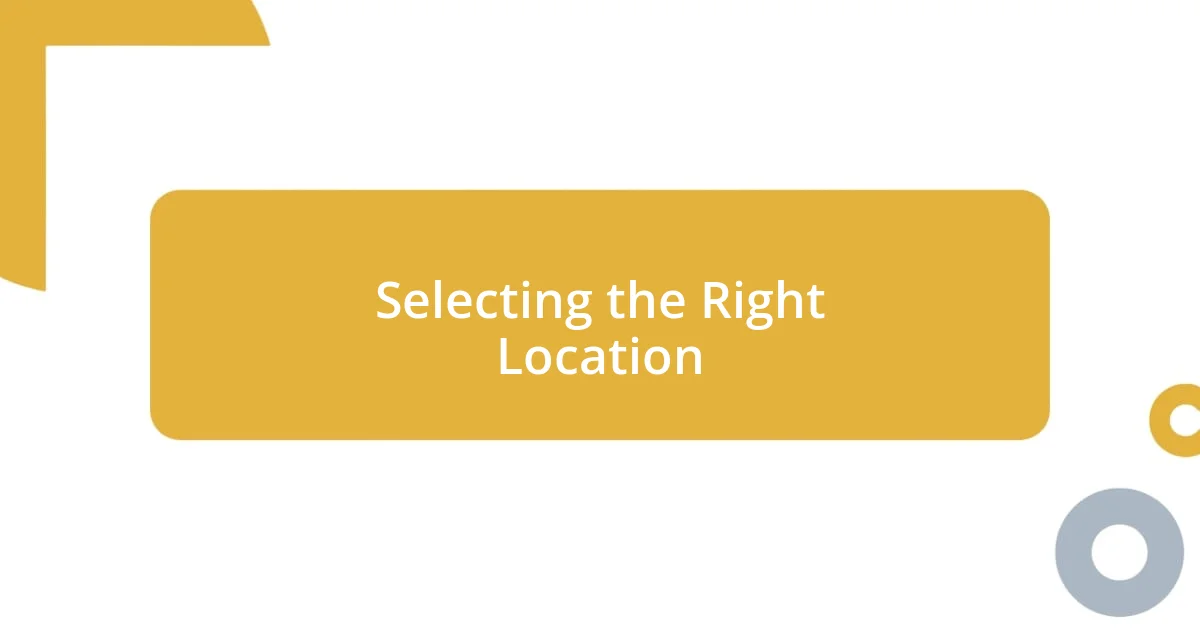
Selecting the Right Location
Choosing the right location for your reader event can make all the difference. I once hosted a small gathering in a cozy corner café that was flooded with sunlight – it set the perfect atmosphere for open conversations. People were relaxed and eager to share, my personal favorite being the spontaneous storytelling that emerged in that inviting space.
Here are some key considerations to keep in mind when selecting your venue:
- Accessibility: Ensure the location is easy to reach for your attendees. Proximity to public transport can influence attendance.
- Capacity: Choose a space that comfortably accommodates your expected audience. Overcrowding can create anxiety, while a too-large venue may feel empty.
- Ambiance: Think about the mood you want to create. A warm, welcoming environment encourages openness and interaction.
- Amenities: Check for necessary facilities like seating, audio-visual equipment, or Wi-Fi. These can enhance the experience and make logistics smoother.
- Acoustics: Consider how sound travels in the space. I remember a venue where soft background music drowned out conversations, reducing the overall engagement.
Selecting the right location is more than just a logistical task; it’s about creating an atmosphere where connections can flourish and stories can be freely shared.
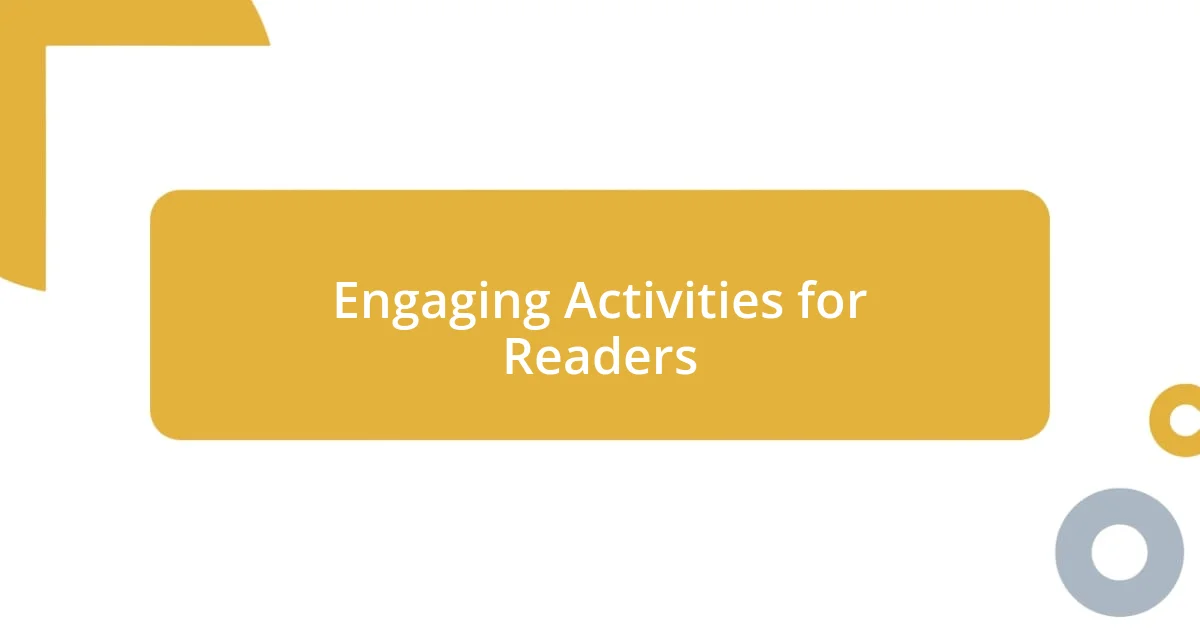
Engaging Activities for Readers
Engaging activities can truly elevate a reader event. One of my favorite ways to encourage participation is through themed discussions. I vividly recall a time when we explored the theme of “unlikely heroes” in literature. Attendees were invited to share their own interpretations, and the variety of stories that emerged was incredible. Those moments not only sparked deep conversations but also fostered a sense of community among participants.
Interactive book tastings can also create excitement and curiosity. Imagine setting up small stations featuring excerpts from different books. I once attached discussion prompts to each table, allowing groups to debate and reflect on what they read together. This format not only made the event dynamic but also helped attendees discover new authors and genres they might not have considered before. Have you ever found a new favorite book in such an engaging way?
Another idea is to incorporate creative workshops tailored to your audience’s interests. I remember co-hosting a poetry workshop where participants created their own pieces inspired by a book we all read together. The enthusiasm in the room was palpable, and it was rewarding to watch attendees gain confidence in sharing their creations. By allowing space for creative expression, I’ve found people are more willing to bond and open up, transforming a simple meeting into a memorable experience.
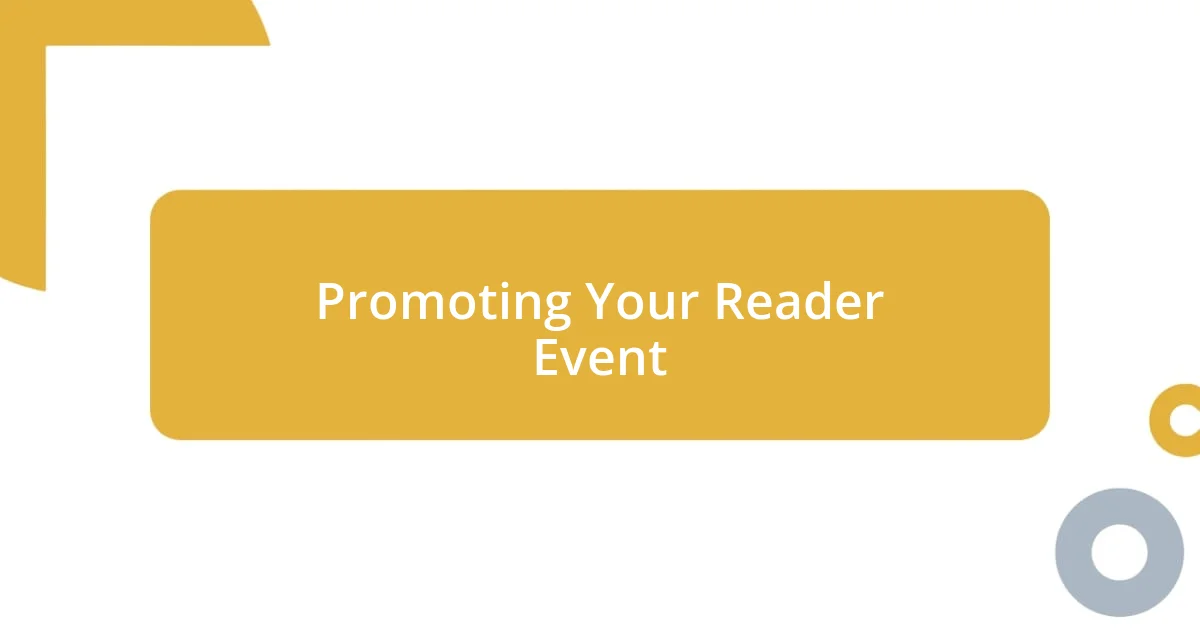
Promoting Your Reader Event
Promoting your reader event is crucial to attracting the right audience and creating an atmosphere of excitement. I often turn to social media as my go-to tool for community outreach. I remember posting enticing images from previous events, paired with engaging captions that sparked curiosity. It’s fascinating how a simple photo can evoke a sense of belonging and create buzz around an upcoming gathering. Have you ever noticed how visuals can tell a story that words sometimes struggle to convey?
Email newsletters are another powerful way to reach your audience. I’ve had success crafting personalized messages that highlight what makes my events unique. It’s all about sharing my enthusiasm; I’ve found that when I express my genuine excitement about a specific theme or guest speaker, my readers feel it too. They respond with eagerness, often forwarding my emails to friends, which broadens the event’s reach. It’s rewarding to watch the community grow simply by sharing my passion.
Additionally, collaborating with local authors or bookstores can amplify your event’s visibility. I once partnered with a local bookstore for a themed book release party, and the energy was contagious. We cross-promoted through our platforms, drawing a diverse crowd excited to engage with both the author and each other. Experiencing that synergy firsthand reiterated for me that promoting an event is not only about getting people through the door but also about creating connections that last well beyond the event itself.
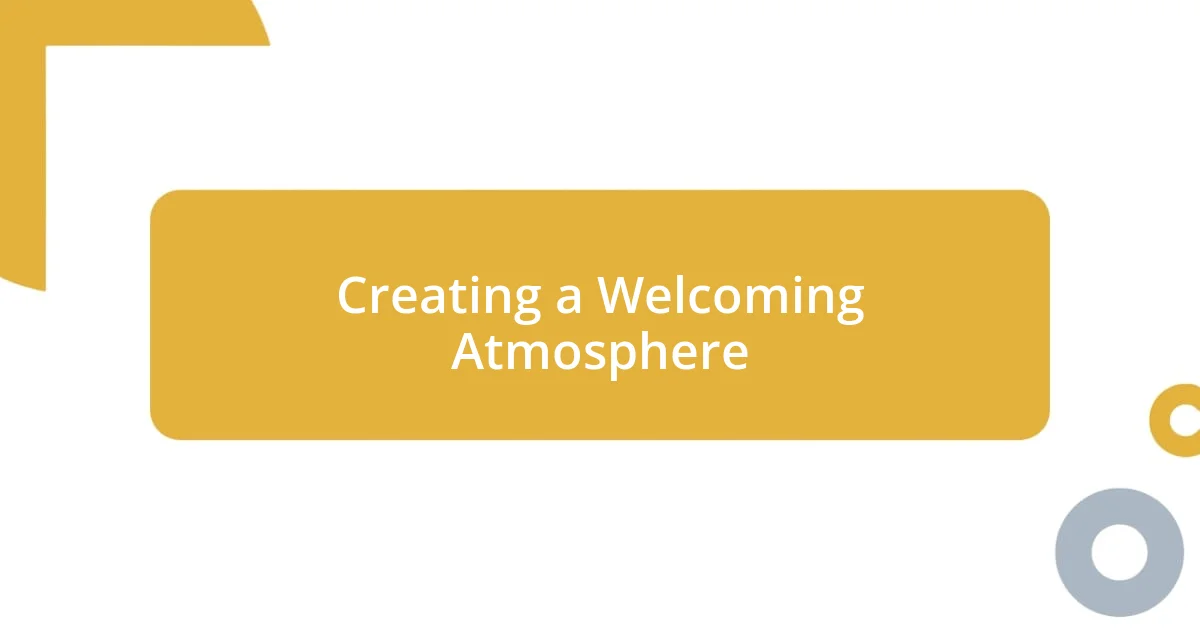
Creating a Welcoming Atmosphere
Creating a welcoming atmosphere is essential for making attendees feel comfortable and valued. I remember a time when I hosted a reading event and decided to decorate the space with soft lighting and cozy seating arrangements. The moment people walked in, they seemed to instantly relax, as if they were stepping into a friend’s living room. Have you ever noticed how the right ambiance can shift the mood of an entire gathering?
Another important aspect is the greeting. I’ve found that a warm smile and a simple, “I’m so glad you’re here!” can go a long way. At one gathering, I made it a point to personally welcome everyone, which sparked conversations even before the event started. It’s amazing how these small gestures can help break the ice and create a sense of belonging.
Engaging with attendees throughout the event also cultivates that inviting spirit. During discussions, I make sure to include quieter voices, asking for their thoughts and insights. This practice not only enriches the dialogue but also reinforces that every opinion matters. I’ve seen timid participants light up when they realize their contributions are appreciated; it’s those moments that truly deepen the connections within the community.
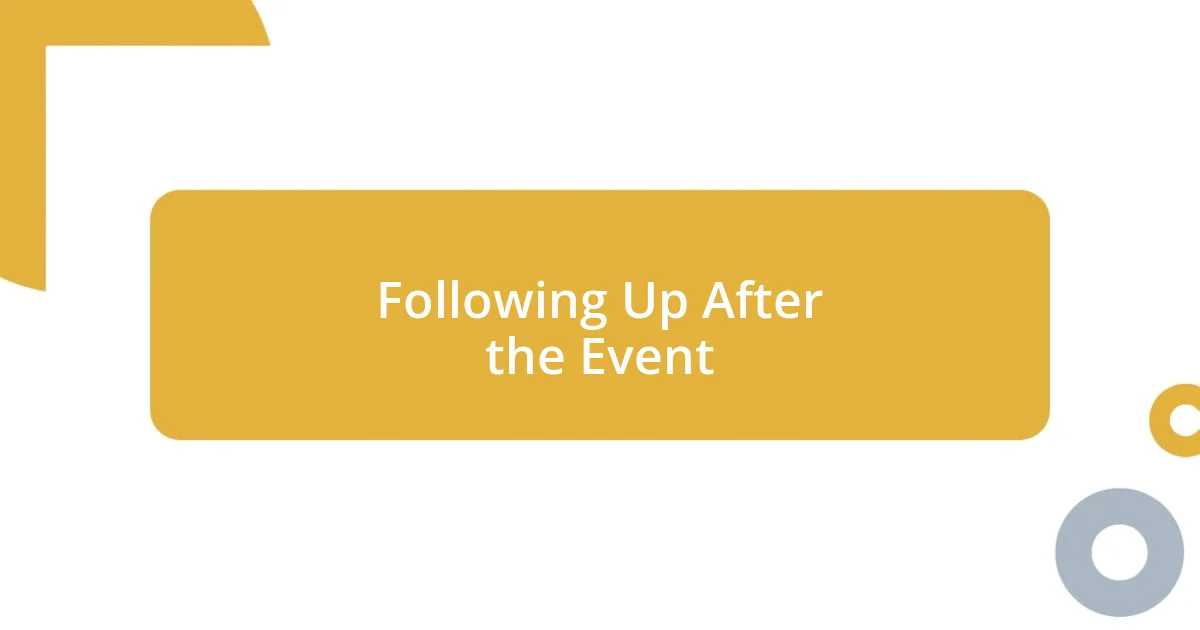
Following Up After the Event
After the event wraps up, I find that following up with attendees is just as vital as the planning that went into it. Sending a heartfelt thank-you email can really make a difference; I remember doing this after a particularly successful book signing. I mentioned specific moments from the event, like a great discussion we had about the author’s work. This personal touch reminded everyone of the shared experience we just had and encouraged them to feel connected even after leaving.
Reflecting on the feedback I received after past events has also shaped my follow-up strategy. Whether it’s through a brief survey or simply asking attendees to reply with thoughts, I’ve learned that people appreciate being asked for their opinions. I once received an email from a participant who suggested a theme for my next gathering, and that dialog sparked an exciting new idea! Isn’t it incredible how a question can open the door for deeper engagement?
Lastly, creating a sense of community post-event is crucial. I’ve made it a point to share photos and memories from our time together on social media. This not only keeps the conversation alive but also invites those who couldn’t attend to feel included and excited for future gatherings. When I see people tagging each other in photos, reminiscing about the event, I can’t help but feel a sense of satisfaction—it shows that those connections are lasting, and that’s what hosting events is all about.












